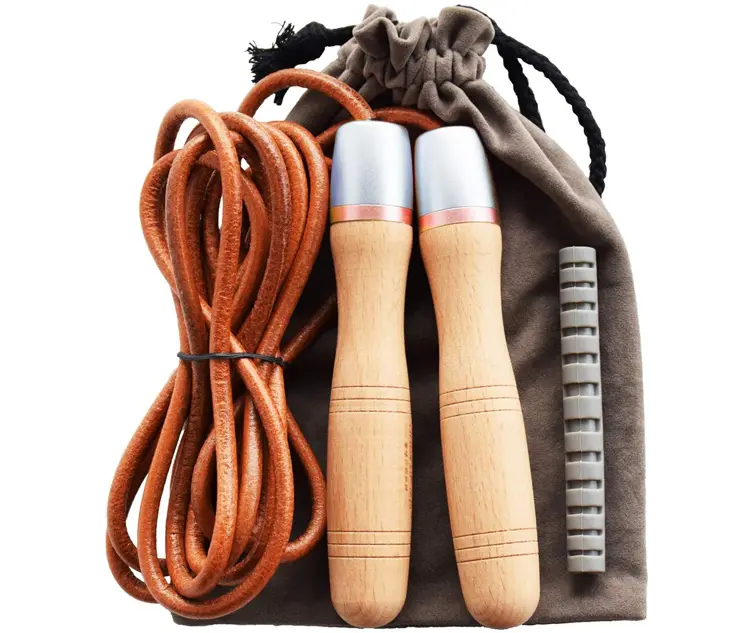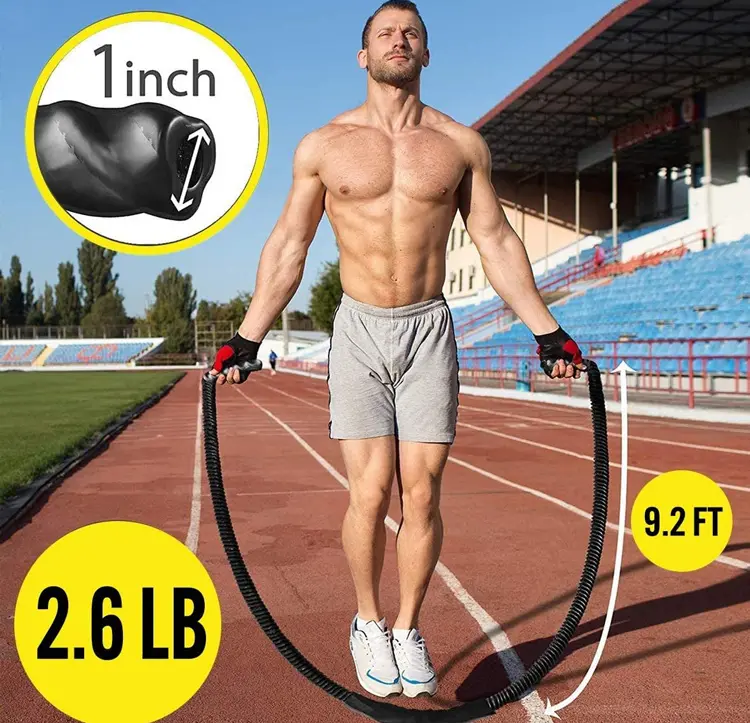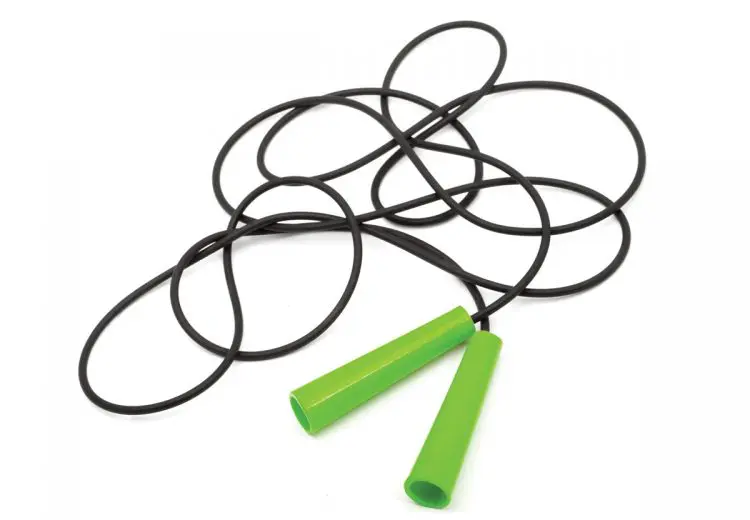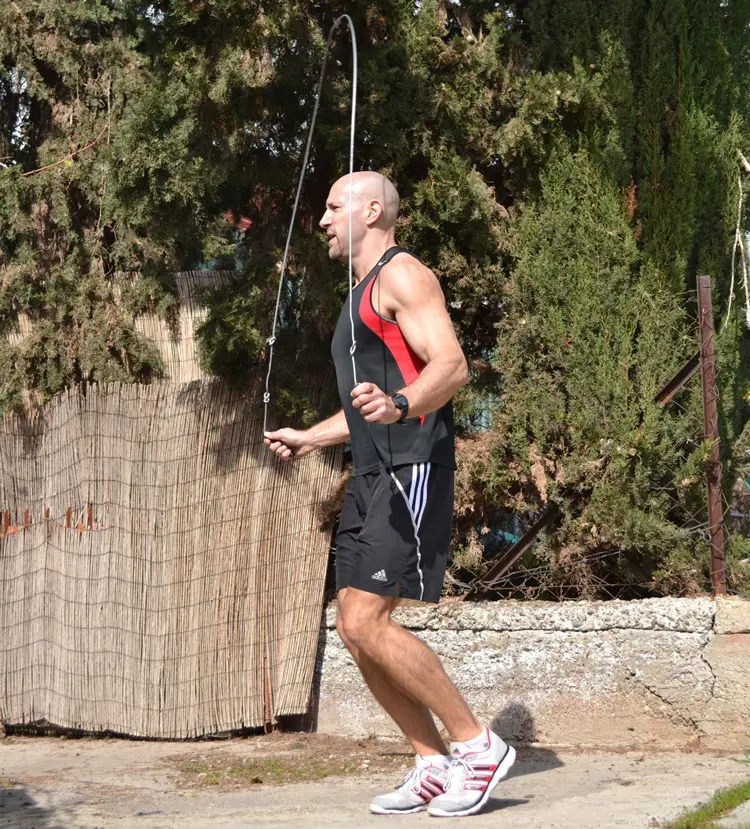What do schoolgirls and some of the toughest athletes on the planet have in common? The answer is jumping rope! Whether you are in a typical playground or a Mixed Martial Arts (MMA) gym, you’ll see people jumping rope, or skipping, as this activity is sometimes known.
So why is this low-tech form of exercise so popular? The answer is simple – it works!
In this article, we reveal the benefits of jumping rope and explain how to get the best from this old-school training tool. Plus, we’ve got some GREAT workouts for you to try.
The Advantages and Benefits of Jump Rope

Jumping rope develops your cardiovascular (heart, lung, and circulatory system) fitness, your eye-hand-foot coordination, strengthens your ankles, legs, and shoulders, and also burns a whole lot of calories.
You can jump rope continuously for extended periods to improve your aerobic fitness or shorter, faster bursts to improve your anaerobic fitness. Tricks like double-unders and triple-unders (two or three turns of the rope per jump) will improve your leg power, and drills like high-knee sprints will improve your leg speed.
Jumping rope is also ideal for high-intensity interval training (HIIT) as you can start and stop quickly and easily. HIIT is an effective way to burn calories and get fit using very brief workouts.
Level Up Your Fitness: Join our 💪 strong community in Fitness Volt Newsletter. Get daily inspiration, expert-backed workouts, nutrition tips, the latest in strength sports, and the support you need to reach your goals. Subscribe for free!
As well as being a highly effective form of exercise, jumping rope is also very accessible and can be performed just about anywhere you have space to turn a rope. Jump ropes are cheap – costing as little as $10.00 – and they seldom break.
Once you have a good jump rope, you have a training partner that will last for years. And while learning to jump rope well can take some time, once mastered, it is a skill that you never really forget.
While there is nothing wrong with running, cycling, or using an elliptical trainer to get fit or burn fat, jumping rope is often more practical. After all, once you’ve got your rope, you can work out at home or almost anywhere else you can find a few yards of space. In short, jumping rope is tough to beat for fat loss and fitness. THAT’s why it’s been popular for so long!
Types of Jump Rope
There are several different styles and many manufacturers of jump ropes. You can pay as little as a couple of dollars for a rope or, if you look hard enough, find jump ropes that cost upward of $100!
Very expensive ropes offer no real benefit over ropes costing almost a tenth as much; however, it’s worth looking at all the different types of rope available so you can choose the right one for you.
Rope ropes
No – not a typo; some jump ropes are actually made of cotton or synthetic rope. Popular with school children, rope ropes are soft and easy to use, but they are not very fast and tend to twist because they usually don’t have handles. If all you have is a piece of rope, you can still get a good workout. But if you are interested in a more effective, enjoyable jump rope training session, you should look elsewhere.
Leather ropes

Not so long ago, leather ropes were cutting-edge technology, especially when coupled with a ball bearing handle to enhance rope smoothness and speed. Leather ropes are faster than rope ropes but, even with well-designed handles, are not as smooth or as quick as more modern designs.
On the plus side, leather ropes tend to be very hardwearing but are also often more expensive than most of the other alternatives. You could do worse than a leather rope, but you could also do better!
Buy this rope from Amazon here.
Plastic speed ropes
Plastic speed ropes are precisely what the name implies – they’re fast and made of plastic. This type of rope is usually very cheap and simply made. The handles are light and typically have carbon or nylon washers to ensure that the rope spins quickly and won’t tangle. They’re usually very hardwearing.
On the downside, most speed ropes are not adjustable, and the only way to shorten them is to tie knots in them.
Ropes with counters in the handles
This type of rope will have either a fibrous or a plastic rope and a digital counter set into one handle. On the plus side, this makes tracking the length of your workouts very easy but, on the downside, you’ll soon be able to do far more rope turns than these types of rope can record – the maximum usually being 999. Forget this type of rope; they’re usually low quality and are not really suitable for anything more than casual, occasional use.
There are also ropes that you can sync with an app to record how many rope turns you’ve done, but this makes what should be a simple, low-tech workout more complicated than it needs to be. These smart ropes are also VERY expensive but don’t really deliver any additional workout benefits.
Weighted ropes

There are two types of weighted ropes – ropes where the handles are heavier than usual and those with thick, heavy ropes. Both are designed to increase the muscular demand of jumping rope.
Weighted handles give your shoulders a good workout but, because the weight is relatively light (just a couple of pounds at most), you won’t develop much in the way of strength or muscle size.
In products where the rope is weighted, the rope itself is usually made of thick metal wire. Some heavy ropes have weighted beads threaded onto them. A weighted rope is harder to turn, which makes your workout more demanding, but the rope a) won’t spin as fast, b) really hurts if you hit yourself and c) is not so good for tricks like crossovers and double unders.
Initially, the slow speed and lack of flexibility may make using this kind of weighted rope seem appealing. Still, once you have mastered the basic jump rope techniques outlined below, a weighted rope may actually limit rather than enhance your workouts. Weighted ropes tend not to be adjustable for length either.
Buy the weighted ropes from Amazon here.
Wire ropes
Smooth, fast, light, and easy to adjust, wire ropes are everything that a good jump rope should be. The thickness of the wire varies from one manufacturer to another and, generally, the thinner the wire, the faster the rope will spin, but even thicker wires are very fast.
On the downside, if there is one, wire ropes are not usually recommended for outdoor use, as rough floors can cause the wire to wear and fray.
Sizing Up Your Jump Rope
One of the most important factors in jump rope training is making sure your rope is the correct length. The wrong size will make your workout a frustrating start again/stop again affair, so it pays to get your rope length right from the start.
Follow these guidelines to ensure that your rope is the correct length for your workouts:
Stand on the middle of your rope with your feet together and your legs straight. Pull the handles up towards your armpits. If the ends of the handles touch your armpits, the rope is the right size. If it doesn’t reach this level, the rope is too short, and you should select another.
If your jump rope is too long, tie a knot in the middle of it and then check again. Tie as many knots as necessary to make the rope the correct length.
Of course, some ropes are adjustable, so you may not need to tie knots to shorten them. Either way, take a moment to make sure your rope is the correct size. You may still need to finetune it, but this should get you pretty close.
Jump Rope Technique Basics
Jumping rope is pretty straightforward, and yet, a lot of people struggle initially. If you are new to jumping rope, follow these instructions:
Start with the rope behind you and your feet together. Swing the rope overhead and jump over as it approaches your feet. Remember to just clear it; you aren’t in a high jump competition, you know! Instead, see how close you can stay to the floor. This will allow you to jump faster and also reduces the impact on your feet and joints.
Try to stick to one jump per rope turn and avoid the temptation to “double bounce” between revolutions. Double jumps make it harder to establish a smooth rhythm.
Keep your hands down at around hip height and only slightly away from your body. If you raise your hands much higher than this, you effectively shorten the rope and increase your likelihood of tripping.
As you become more proficient, try to increase the speed of your rope turns. Once you have mastered double-footed skipping, it’s time to make like Rocky and jump rope like a pro…
Jogging
Jogging on the spot requires a little more coordination than two-footed jumps but usually means you can spin the rope faster. Transition from two-footed jumps to running in place. Keep your footfalls low and light to minimize impact. You should be up on the balls of your feet.
Boxer style
Boxer style aka heel-toe jump rope, start with your basic two-footed or jogging technique, and then, when you are ready, kick one foot forwards so that you land with the ball of one foot and the heel of the other on the floor. Change legs on the next jump and continue alternating your feet in this way for the duration of your workout.
Level Up Your Fitness: Join our 💪 strong community in Fitness Volt Newsletter. Get daily inspiration, expert-backed workouts, nutrition tips, the latest in strength sports, and the support you need to reach your goals. Subscribe for free!
Once mastered, you’ll be able to move forwards, sideways, and backward using this heel-toe action, and it can be used as a linking move between other, more challenging, jump rope drills.
Knee lift sprints
This is an excellent drill for increasing your heart rate and making your jump rope workouts more demanding. From the basic heel-toe technique, transition into jogging on the spot. Gradually lift your knees up in front of you until your thighs are parallel to the floor.
Pick up the pace and try to turn the rope as fast as possible while moving your feet as quickly as you can. Do not lean back when performing this drill. In fact, you may find that you can go faster if you lean forwards slightly.
Crossovers
Jumping rope can make your shoulders ache, especially if you are new to this form of exercise or are training for long periods. Periodically crossing your arms can help to alleviate this discomfort. Stick with double-footed jumps when first trying this technique and then progress onto heel-toe and jogging when you feel ready.
As you turn the rope and it passes overhead, cross your hands to form a loop. Jump through the loop and then uncross your hands as the rope passes beneath you. Because the loop in the rope is comparatively small, you may need to hunch your shoulders and tuck up slightly as you jump through it. Start off by performing single crossovers and then try to link multiple crossovers together.
Lateral or side-to-side jumps
Jumping side to side is a nice way to add some agility work to your jump rope workout and can help improve your sideways dodging ability, which is useful if you play soccer, basketball, or similar ball sports.
With your feet together, jump rope normally and then add a slight side to side action as though you were jumping over a line or low hurdle. Imagine you are downhill skiing. This side-to-side action places an emphasis on the muscles on the outside of your thighs and hips.
Double under
This is a cool trick that can really crank up your heart rate and will also develop lower body jumping power. Double unders are a great way to make your jump rope workouts much more intense.
Jump rope normally and, when you are ready, turn your rope faster and jump a little higher. You are aiming to turn the rope
e twice before landing. Initially, after a successful double under, return to your usual technique and then, when you are ready, perform another one.
Once you have mastered single double unders, try to link a few together. With practice, you will be able to do twenty or more in a row, which really cranks up your heart rate! When you are comfortable with each of these techniques, try mixing them into a free-form routine.
Traveling
Using any of the previous techniques, and assuming you have sufficient space, move forward, backward, and sideways around your training area. For variety, you could jog forward, do high-knee sprints on the spot for a moment, and then do boxer style back to your starting place. Mix and match the techniques as you see fit.
Moving around not only challenges your ability to jump rope; it also makes sure you do not overload one particular part of your foot, which is an important consideration for preventing injury.
Jump rope considerations
We hope we’ve inspired you to start jumping rope. But, before you begin, take the following information into account to ensure that your workouts are as safe and enjoyable as possible:
Surface – jumping rope involves less impact than running, but it’s still classed as a high-impact activity. If possible, avoid doing jump rope workouts on unforgiving surfaces like concrete or tarmac. Sprung wooden floors are best, and matted floors work well too.
If you HAVE to work out on a hard floor, make sure you change up your moves to avoid overloading any one part of your feet. Also, include some traveling for the same reason.
Footwear – leading on from the point above, shock-absorbing shoes can take a lot of the pain out of jumping rope. Dig out your cushioned running shoes and avoid using your minimalist workout or weightlifting shoes.
Build up gradually – because of the impact of jumping rope, you should rein in your enthusiasm and avoid doing too much too soon. Long jump rope workouts can leave you with sore feet and shins and could even cause stress fractures. Start with short workouts and increase gradually as you become accustomed to the demands of jumping rope.
Space – you can jump rope in quite a compact area, but you still need to make sure that you have enough room around you to avoid hitting anything (or anyone) with your rope. Don’t forget to check overhead; hitting a light fixture or ceiling fan will bring your workout to an abrupt halt and could cause serious injury.
Jump Rope Workouts
While there is nothing wrong with jumping rope for a set time, such as 20 minutes, that will soon get old. Make jump rope more enjoyable by trying one of these tried and tested workouts.
1. Three-minute rounds
Inspired by the length of a typical round of boxing, skip fast for three minutes and then rest for 60 seconds. Repeat for 3-6 rounds.
2. Jump rope and burpee descending pyramid
This short but sweet workout is against the clock and really challenges your skipping ability and fitness. Perform ten burpees and then skip until you have performed fifty rope turns. Then do nine burpees followed by another fifty rope turns. Keep reducing the burpees until you reach one rep. This is a great “finisher” at the end of a strength training workout.
3. Jump and swing
Combining kettlebell swings and skipping, this no-frills workout is straightforward but super effective. Set your timer, so it beeps every three minutes.
Perform 20-30 kettlebell swings and then grab your rope and jump until the timer beeps again. Perform another set of swings and repeat for 4-8 sets.
Feel free to adjust the timings to suit your individual fitness level; two minutes work equally well and can be more demanding as the jumping rope is actually the recovery part of this workout!
4. Jump rope Cindy
Cindy is a popular bodyweight CrossFit workout. It works every major muscle in your body. This variation also includes some jump rope to increase your calorie expenditure and add a welcome cardiovascular element to the workout.
Do ten laps of the following, starting each lap every 2ndminute. If you are VERY fit, continue for 30 minutes.
5. Double under pyramid
This workout is an exercise in self-regulation, which means you keep going until you cannot continue, adjusting the duration and intensity according to how you feel. Start your stopwatch or keep an eye on the second hand of a clock…
- At the top of the first minute do two double unders, rest for the time remaining
- At the top of the second minute do four double unders
- At the top of the third minute do six double unders
- At the top of the fourth minute do eight double unders
- At the top of the fifth minute do ten double unders, etc.
Keep on adding two more double unders each minute until you are unable to continue.
6. Tabata skipping intervals
This jump rope workout is the shortest but, in many ways, the hardest. Jump rope as fast as possible for twenty seconds (knee lift sprints or double unders are best) and then rest for ten seconds. Repeat for eight sets.
If you aren’t thoroughly exhausted at the end of this short but sharp workout, you probably weren’t going fast enough!
7. Big tunes workout
Put on your favorite fast-paced piece of music and jump rope in time to it. You could even change jump rope technique during different parts of the song, such as when you hear a specific lyric or during the chorus. Line up 2-4 songs for a longer workout.
140-160 beats per minute (BPM) is usually about right. Most music streaming platforms have mixed playlists at specified tempos that are ideal for this workout.
Jump Rope Guide – Wrapping Up
Many exercisers think that jumping rope is too old-school and low-tech to be effective, but those are the exact reasons this simple training tool deserves to be part of your workout. Jumping rope is a very natural activity and, while it can be tricky to learn and master, it’s something you never forget how to do.
Jumping rope is a great way to warm up before strength training and can also provide a time-efficient stand-alone cardio workout. Jump rope intervals are hard to beat for conditioning and fat burning.
There is nothing wrong with working out on something like a $2000 assault bike, but for $20 or less, you can achieve very similar results.
If you are new to jumping rope, or you’ve not done it for a while, use this guide to help you put this fantastic exercise into your workouts.
After all, if it’s good enough for most boxers and MMA fighters, it’ll probably do you good, too!















